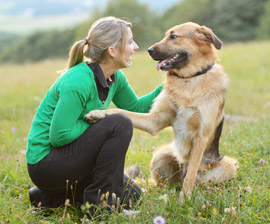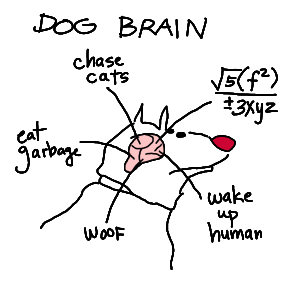
Call us Now ![]() +91-8744012053
+91-8744012053
Mon - Sat ~ 10:00 AM - 6:00 PM
Follow & Like
.png)


Call us Now ![]() +91-8744012053
+91-8744012053
Mon - Sat ~ 10:00 AM - 6:00 PM
Follow & Like
.png)


Ever wondered what your dog thinks of you as a parent or the barrage of commands you shout at it all day? Can dogs actually process information and does their brain function like that of humans?
Image:http://hellonuzzle.com/
Dogs can think and they do undergo cognitive processes.
Dr. Jill Sackman, has a PhD in cellular & molecular biology and has confirmed the fact that dogs can think. Dr. Sackman a clinician in behavioral medicine and a senior medical director of BluePearl veterinary Partners’ Michigan hospitals further believes that a dog’s level of cognition is same as that of a human child aged between three to five years.
Cognition is the mental action or process of acquiring knowledge and understanding through practice, thinking and senses. Some cognitive processes are problem solving, decision making, memory, knowledge, evaluation, comprehension and attention. In day to day lives a dog comes across situations that require it to make choices, evaluate a condition or follow commands of the owner. A dog can recognize and respond to familiar voices/people. It can sense danger or an enemy. It will be comfortable around those it considers friends. A canine brain can function quite well and to test the same if you put two food bowls in front of your dog, it will be able to gauge the one with more food in it.

A study by Blue Pearl veterinary Partners’ Michigan hospitals indicates that a dog’s level of mental cognition is same as that of a human child aged between three to five years. Image:http://en.paperblog.com/
Dogs are creatures of habit, they like to follow a fixed schedule when it comes to daily dog exercise and being fed. All of these activities, reactions and habits point out that a dog can definitely think! However there is still little known about what exactly goes on in a canine mind and how their brain processes/understands information. As rightly put by Dr. Rachel Barrack of Animal Acupuncture in New York City, “Just as it’s impossible to read another person’s thoughts, it is impossible to speculate exactly what a dog is thinking.”

Your pet dog can talk to you, however sans words! The conversations can happen only if you are able to read its body language and the sounds it makes. Image:http://www.humanesociety.org/
A dog brain is quite similar to the human brain
MRI studies not only point out structural similarities but also the fact that in human and canine brain the same sections light up when reacting to things/events/stimuli. Scientists have also found out that certain skill sets come together in dogs the same way it is with humans. This has been explained by Dr. Sackman by citing the example that a dog that is fast and accurate in one task will be agile and accurate at another chore as well. In a human brain too some cognitive skills are bunched together. If a person is found to be good at mathematics, he/she in all probability will be good at problem solving as well.
A condition similar to Alzheimer’s disease is found to develop in aged dogs. Also the way humans respond to fear or process memories, is similar to dogs. Dogs also have a sense of spatial awareness that is the ability to be aware of not just oneself but also other objects in a given space.

Dogs are creatures of habit, they like to follow a fixed schedule when it comes to daily exercise and being fed. All of these activities, reactions and habits point out that a dog can definitely think!. Image:https://blogs.scientificamerican.com
However the size of a dog’s brain is smaller than ours in relation to the respective body size. Dr. JP McCue is a board-certified veterinary neurologist at NYC’s Animal Medical Center and has highlighted a few other dissimilarities like the human brain has more surface area due to the presence of more folds. Also the prefrontal cortex (PFC) in humans is greatly developed as compared to in dogs. PFC covers the front part of the frontal lobe and is responsible for the regulation of complex cognitive, emotional and behavioural functioning and it is here the higher level of thoughts happen.
Dogs have emotions and can understand humans
A dog’s ability to express emotions is same as that of a two and a half year old human child. It is capable of feeling and communicating emotions such as excitement & joy, jealousy, suspicion, shyness, distress & sorrow, disgust, anger, fear, contentment, love and affection.
Since time immemorial dogs have been amiably living around human species and are the oldest domesticated animal. In the course of co-existing and evolving together dogs have come to understand humans and communicate with them effectively by picking up cues via body language, familiarity of voices and smells. Dogs have extremely sensitive noses and use a larger part of their brains for identifying and examining smells around them. Dr. Rachel Barrack believes that dogs link scent with memories.
Yes! Your Dog Can Communicate With You, Say Veterinarians
Your pet dog can talk to you, however sans words! The conversations can happen only if you are able to read dogs’ body language and the sounds it makes.
Scientists are continuously working to unravel significant and deeper facts about dog-thinking and cognitive processes with newer breakthroughs to be made.
Article Resource:
http://www.petmd.com/dog/behavior/dog-brain-facts-understanding-canine-cognition